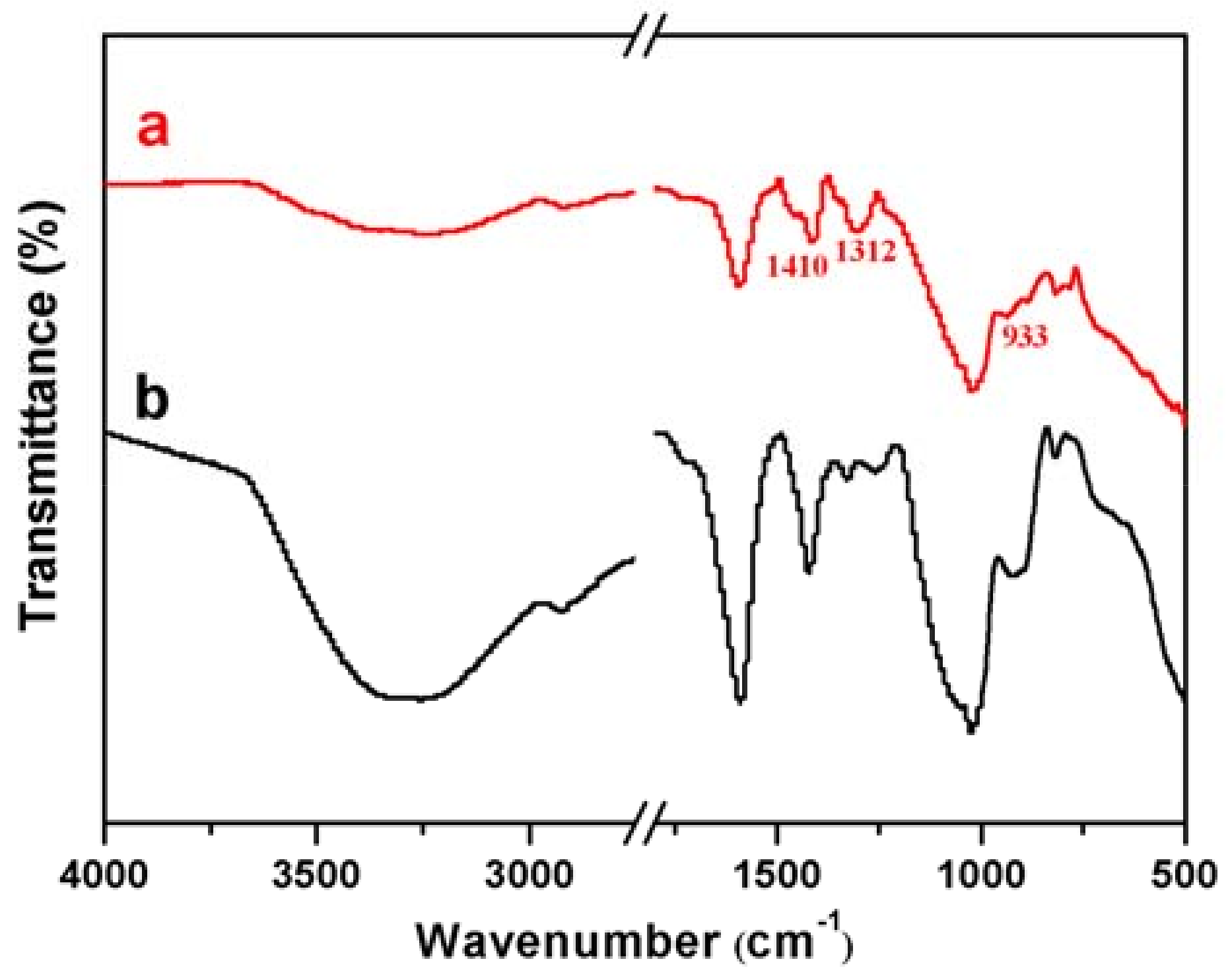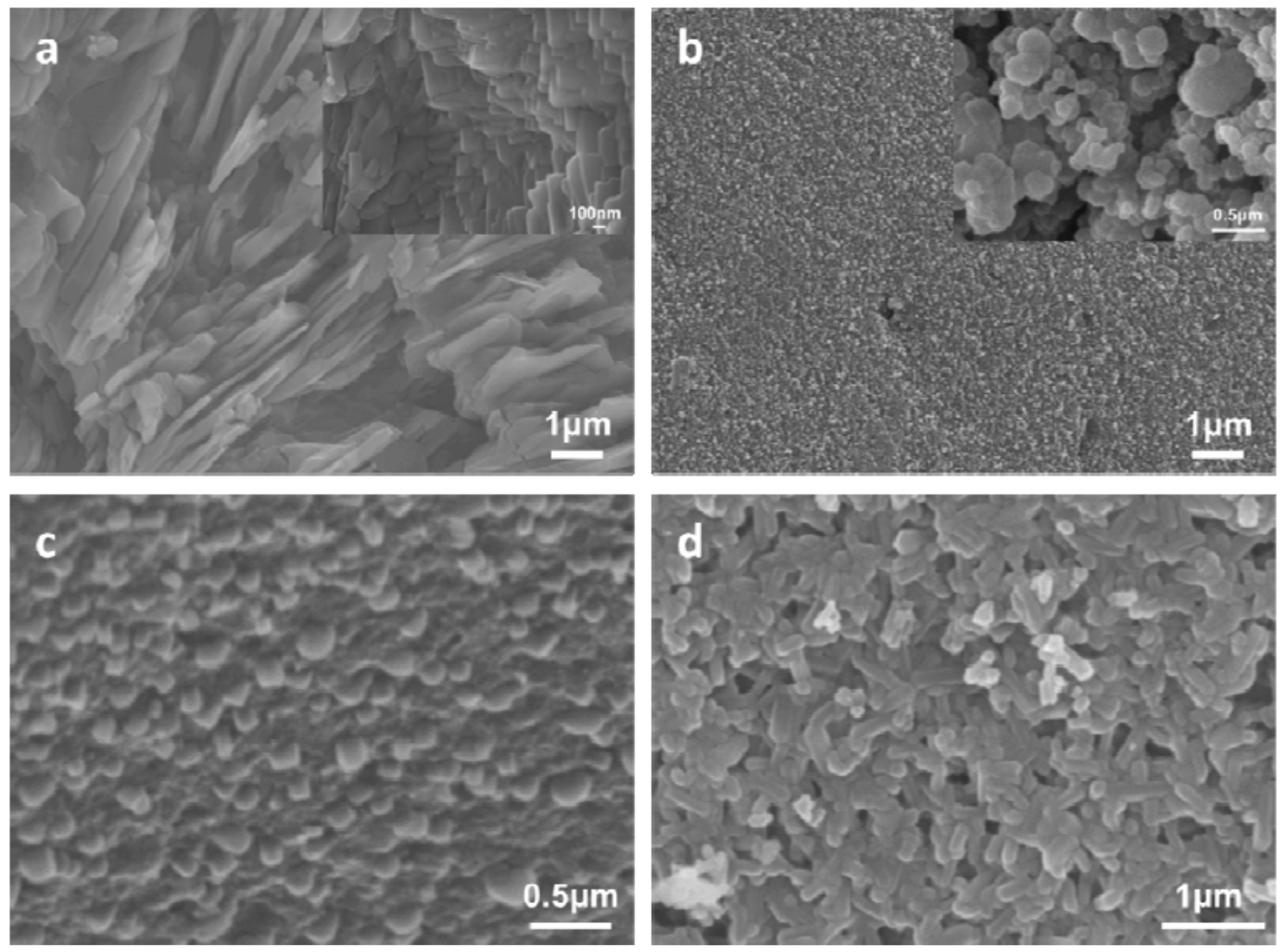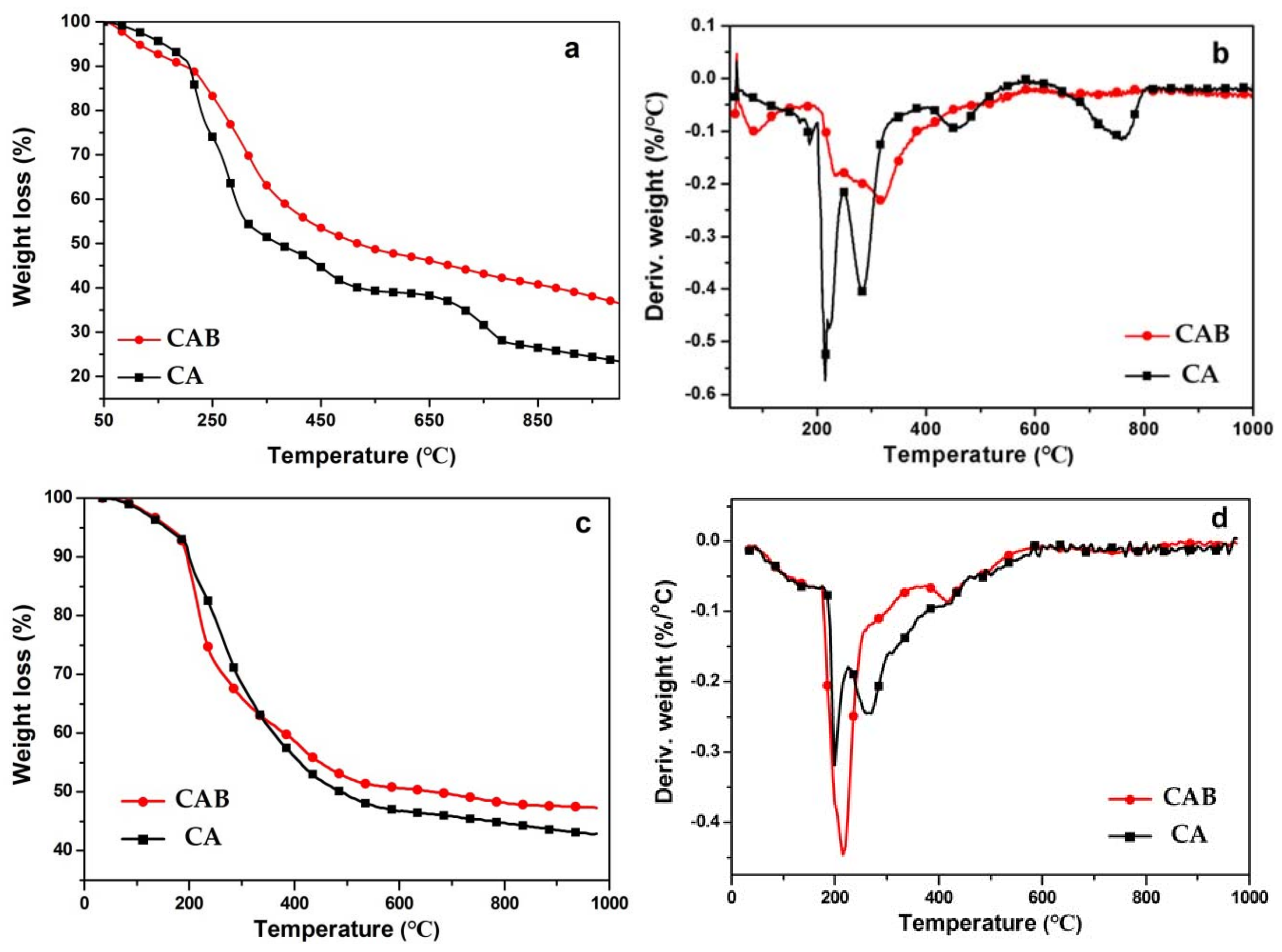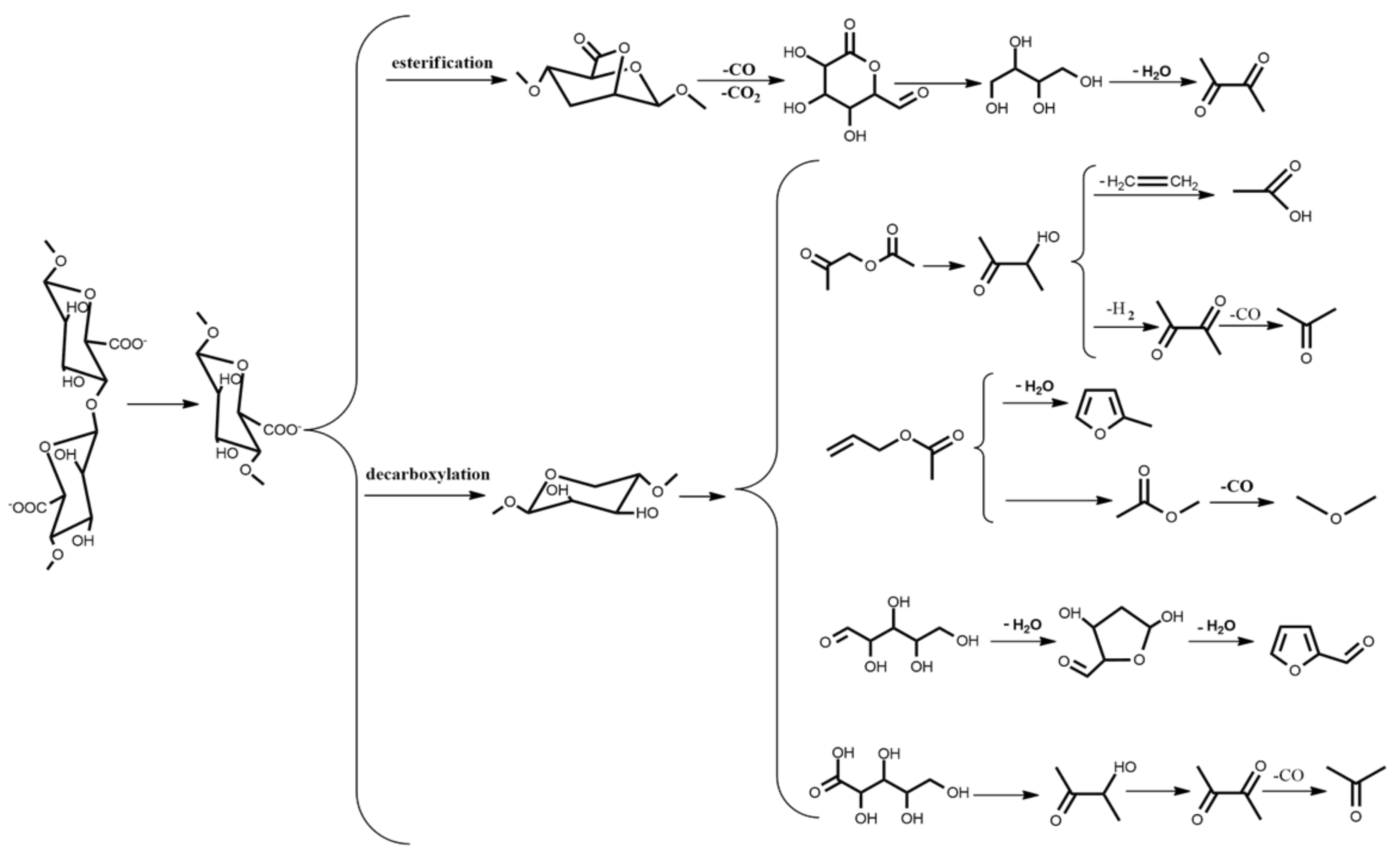Highly Efficient Flame Retardant Hybrid Composites Based on Calcium Alginate/Nano-Calcium Borate
Abstract
:1. Introduction
2. Materials and Methods
2.1. Materials
2.2. Preparation of the Calcium Alginate/Nano-Calcium Borate Composites
2.3. Measurements and Characterizations
2.3.1. Limiting Oxygen Index (LOI)
2.3.2. Vertical Burning Rate (UL-94)
2.3.3. X-ray Diffractometry (XRD)
2.3.4. Fourier Transform Infrared (FTIR)
2.3.5. Scanning Electron Microscopy (SEM)
2.3.6. Thermogravimetric Analysis (TGA)
2.3.7. Cone Calorimetry (CONE)
2.3.8. Pyrolysis–Gas Chromatograpgy–Mass Spectrometry (Py-GC-MS)
3. Results and Discussion
3.1. LOI and UL-94
3.2. XRD Analysis
3.3. FTIR Analysis
3.4. SEM
3.5. TGA and DTG
3.5.1. Thermal-Oxidative Degradation Behaviors under Air
3.5.2. Thermal Degradation Behaviors under N2
3.6. CONE
3.7. Py-GC-MS
4. Conclusions
Author Contributions
Funding
Conflicts of Interest
References
- Wang, Y.; De, S.; Yan, N. Rational control of nano-scale metal-catalysts for biomass conversion. Chem. Commun. 2016, 52, 6210–6224. [Google Scholar] [CrossRef] [PubMed]
- Mu, B.; Wang, H.; Hao, X.; Wang, Q. Morphology, mechanical properties and dimensional stability of biomass particles/high density polyethylene composites: Effect of species and composition. Polymers 2018, 10, 308. [Google Scholar] [CrossRef]
- Moniri, M.; Boroumand Moghaddam, A.; Azizi, S.; Abdul Rahim, R.; Bin Ariff, A.; Zuhainis Saad, W.; Navaderi, M.; Mohamad, R. Production and status of bacterial cellulose in biomedical engineering. Nanomaterials 2017, 7, 257. [Google Scholar] [CrossRef]
- Chen, H.-B.; Wang, Y.-Z.; Sánchez-Soto, M.; Schiraldi, D.A. Low flammability, foam-like materials based on ammonium alginate and sodium montmorillonite clay. Polymer 2012, 53, 5825–5831. [Google Scholar] [CrossRef]
- Sato, K.; Tanaka, K.; Takata, Y.; Yamamoto, K.; Kadokawa, J. Fabrication of cationic chitin nanofiber/alginate composite materials. Int. J. Biol. Macromol. 2016, 91, 724–729. [Google Scholar] [CrossRef] [PubMed]
- Liu, Y.; Zhao, X.-R.; Peng, Y.-L.; Wang, D.; Yang, L.; Peng, H.; Zhu, P.; Wang, D.-Y. Effect of reactive time on flame retardancy and thermal degradation behavior of bio-based zinc alginate film. Polym. Degrad. Stab. 2016, 127, 20–31. [Google Scholar] [CrossRef]
- Liu, D.; Zhao, K.; Qi, M.; Li, S.; Xu, G.; Wei, J.; He, X. Preparation of protein molecular-imprinted polysiloxane membrane using calcium alginate film as matrix and its application for cell culture. Polymers 2018, 10, 170. [Google Scholar] [CrossRef]
- Das, D.; Bang, S.; Zhang, S.; Noh, I. Bioactive molecules release and cellular responses of alginate-tricalcium phosphate particles hybrid gel. Nanomaterials 2017, 7, 389. [Google Scholar] [CrossRef] [PubMed]
- Aimé, C.; Coradin, T. Nanocomposites from biopolymer hydrogels: Blueprints for white biotechnology and green materials chemistry. J. Polym. Sci. Part. B Polym. Phys. 2012, 50, 669–680. [Google Scholar] [CrossRef]
- Lee, K.Y.; Mooney, D.J. Alginate: Properties and biomedical applications. Prog. Polym. Sci. 2012, 37, 106–126. [Google Scholar] [CrossRef] [PubMed] [Green Version]
- Liu, Y.; Zhang, C.J.; Zhao, J.C.; Guo, Y.; Zhu, P.; Wang, D.Y. Bio-based barium alginate film: Preparation, flame retardancy and thermal degradation behavior. Carbohydr. Polym. 2016, 139, 106–114. [Google Scholar] [CrossRef] [PubMed]
- Zhao, K.; Zhang, X.; Wei, J.; Li, J.; Zhou, X.; Liu, D.; Liu, Z.; Li, J. Calcium alginate hydrogel filtration membrane with excellent anti-fouling property and controlled separation performance. J. Membr. Sci. 2015, 492, 536–546. [Google Scholar] [CrossRef]
- Zhao, D.; Liu, C.J.; Zhuo, R.X.; Cheng, S.X. Alginate/CaCO3 hybrid nanoparticles for efficient codelivery of antitumor gene and drug. Mol. Pharm. 2012, 9, 2887–2893. [Google Scholar] [CrossRef] [PubMed]
- Googerdchian, F.; Moheb, A.; Emadi, R. Lead sorption properties of nanohydroxyapatite–alginate composite adsorbents. Chem. Eng. J. 2012, 200–202, 471–479. [Google Scholar] [CrossRef]
- Su, C.-H.; Kumar, G.V.; Adhikary, S.; Velusamy, P.; Pandian, K.; Anbu, P. Preparation of cotton fabric using sodium alginate-coated nanoparticles to protect against nosocomial pathogens. Biochem. Eng. J. 2017, 117, 28–35. [Google Scholar] [CrossRef]
- Carneiro-da-Cunha, M.G.; Cerqueira, M.A.; Souza, B.W.S.; Carvalho, S.; Quintas, M.A.C.; Teixeira, J.A.; Vicente, A.A. Physical and thermal properties of a chitosan/alginate nanolayered PET film. Carbohydr. Polym. 2010, 82, 153–159. [Google Scholar] [CrossRef]
- Kim, J.H.; Park, S.; Kim, H.; Kim, H.J.; Yang, Y.H.; Kim, Y.H.; Jung, S.K.; Kan, E.; Lee, S.H. Alginate/bacterial cellulose nanocomposite beads prepared using Gluconacetobacter xylinus and their application in lipase immobilization. Carbohydr. Polym. 2017, 157, 137–145. [Google Scholar] [CrossRef] [PubMed]
- Jouannin, C.; Vincent, C.; Dez, I.; Gaumont, A.C.; Vincent, T.; Guibal, E. Study of alginate-supported ionic liquid and Pd catalysts. Nanomaterials 2012, 2, 31–53. [Google Scholar] [CrossRef] [PubMed]
- Liu, Y.; Li, Z.; Wang, J.; Zhu, P.; Zhao, J.; Zhang, C.; Guo, Y.; Jin, X. Thermal degradation and pyrolysis behavior of aluminum alginate investigated by TG-FTIR-MS and Py-GC-MS. Polym. Degrad. Stab. 2015, 118, 59–68. [Google Scholar] [CrossRef]
- Serrano-Aroca, A.; Ruiz-Pividal, J.F.; Llorens-Gamez, M. Enhancement of water diffusion and compression performance of crosslinked alginate films with a minuscule amount of graphene oxide. Sci. Rep. 2017, 7, 11684. [Google Scholar] [CrossRef] [PubMed]
- Papageorgiou, S.K.; Kouvelos, E.P.; Favvas, E.P.; Sapalidis, A.A.; Romanos, G.E.; Katsaros, F.K. Metal-carboxylate interactions in metal-alginate complexes studied with FTIR spectroscopy. Carbohydr. Res. 2010, 345, 469–473. [Google Scholar] [CrossRef] [PubMed]
- Llorens-Gámez, M.; Serrano-Aroca, Á. Low-cost advanced hydrogels of calcium alginate/carbon nanofibers with enhanced water diffusion and compression properties. Polymers 2018, 10, 405. [Google Scholar] [CrossRef]
- Zhang, J.; Ji, Q.; Shen, X.; Xia, Y.; Tan, L.; Kong, Q. Pyrolysis products and thermal degradation mechanism of intrinsically flame-retardant calcium alginate fibre. Polym. Degrad. Stab. 2011, 96, 936–942. [Google Scholar] [CrossRef]
- Chen, H.B.; Shen, P.; Chen, M.J.; Zhao, H.B.; Schiraldi, D.A. Highly efficient flame retardant polyurethane foam with alginate/clay aerogel coating. ACS Appl Mater. Interfaces 2016, 8, 32557–32564. [Google Scholar] [CrossRef] [PubMed]
- Li, J.; Li, Z.; Zhao, X.; Deng, Y.; Xue, Y.; Li, Q. Flame retardancy and thermal degradation mechanism of calcium alginate/CaCO3 composites prepared via in situ method. J. Therm. Anal. Calorim. 2017, 131, 2167–2177. [Google Scholar] [CrossRef]
- Ko, Y.G.; Choi, U.S. Diverse applications of fibers surface-functionalized with nano- and microparticles. Compos. Sci. Technol. 2013, 79, 77–86. [Google Scholar] [CrossRef]
- Ngo, Y.H.; Li, D.; Simon, G.P.; Garnier, G. Paper surfaces functionalized by nanoparticles. Adv. Colloid Interface Sci. 2011, 163, 23–38. [Google Scholar] [CrossRef] [PubMed]
- Voisin, H.; Bergstrom, L.; Liu, P.; Mathew, A.P. Nanocellulose-based materials for water purification. Nanomaterials 2017, 7, 57. [Google Scholar] [CrossRef] [PubMed]
- Tian, Y.; He, Y.; Yu, L.; Deng, Y.; Zheng, Y.; Sun, F.; Liu, Z.; Wang, Z. In situ and one-step synthesis of hydrophobic zinc borate nanoplatelets. Colloids Surf. Physicochem. Eng. Aspects 2008, 312, 99–103. [Google Scholar] [CrossRef]
- Geng, Y.-J.; Liu, Z.-H. Preparation and thermodynamic characterization of 2CaO·B2O3 H2O nanomaterials with enhanced flame retardant properties. Colloids Surf. Physicochem. Eng. Asp. 2017, 522, 563–568. [Google Scholar] [CrossRef]
- Zhu, W.; Zhang, X.; Wang, X.; Zhang, H.; Zhang, Q.; Xiang, L. Short belt-like Ca2B2O5·H2O nanostructures: Hydrothermal formation, FT-IR, thermal decomposition, and optical properties. J. Cryst. Growth 2011, 332, 81–86. [Google Scholar] [CrossRef]
- Lewin, M. Some comments on the modes of action of nanocomposites in the flame retardancy of polymers. Fire Mater. 2003, 27, 1–7. [Google Scholar] [CrossRef]
- Liu, Z.-H.; Xue, L. Preparation of nanoplates assembled 4CaO·5B2O3·7H2O oval-like microspheres via a hydrothermal method. Mater. Lett. 2008, 62, 2692–2695. [Google Scholar] [CrossRef]
- Attia, N.F. Organic nanoparticles as promising flame retardant materials for thermoplastic polymers. J. Therm. Anal. Calorim. 2016, 127, 2273–2282. [Google Scholar] [CrossRef]
- Chen, W.; Liu, Y.; Liu, P.; Xu, C.; Liu, Y.; Wang, Q. The preparation and application of a graphene-based hybrid flame retardant containing a long-chain phosphaphenanthrene. Sci. Rep. 2017, 7, 8759. [Google Scholar] [CrossRef] [PubMed] [Green Version]
- Wang, S.; Tang, Y.; Schobert, H.H.; Guo, Y.N.; Gao, W.; Lu, X. FTIR and simultaneous TG/MS/FTIR study of Late Permian coals from Southern China. J. Anal. Appl. Pyrolysis 2013, 100, 75–80. [Google Scholar] [CrossRef]
- Wu, S.; Shen, D.; Hu, J.; Xiao, R.; Zhang, H. TG-FTIR and Py-GC-MS analysis of a model compound of cellulose-glyceraldehyde. J. Anal. Appl. Pyrolysis 2013, 101, 79–85. [Google Scholar] [CrossRef]
- Shi, R.; Tan, L.; Zong, L.; Ji, Q.; Li, X.; Zhang, K.; Cheng, L.; Xia, Y. Influence of Na(+) and Ca(2+) on flame retardancy, thermal degradation, and pyrolysis behavior of cellulose fibers. Carbohydr. Polym. 2017, 157, 1594–1603. [Google Scholar] [CrossRef] [PubMed]
- Liu, Y.; Zhao, J.-C.; Zhang, C.-J.; Cui, L.; Guo, Y.; Zhu, P.; Zhang, H.; Zheng, Z.-W.; Wang, D.-Y. Flame retardancy and thermal degradation properties of cotton/alginate fabric. J. Therm. Anal. Calorim. 2016, 127, 1543–1551. [Google Scholar] [CrossRef]
- Zhang, J.; Ji, Q.; Zhang, P.; Xia, Y.; Kong, Q. Thermal stability and flame-retardancy mechanism of poly (ethylene terephthalate)/boehmite nanocomposites. Polym. Degrad. Stab. 2010, 95, 1211–1218. [Google Scholar] [CrossRef]








| Samples | LOI (%) | UL-94 |
|---|---|---|
| CA | 48 | V-0 |
| CAB | >60 | V-0 |
| Samples | THR (MJ/m2) | PHRR (kW/m2) | TSR (m2/m2) | Residue (%) |
|---|---|---|---|---|
| CA | 6.76 | 46.6 | 70.5 | 33.1 |
| CAB | 5.51 | 34.3 | 130.1 | 35.3 |
| Molecular Structure Name of Compound | T = 250 °C | T = 400 °C | T = 750 °C | ||||
|---|---|---|---|---|---|---|---|
| Time | Area | Time | Area | Time | Area | ||
 | Carbon dioxide | 0.53 | 89.27 | 2.21 | 0.78 | 1.44 | 51.26 |
 | Water | 1.39 | 7.70 | - | - | - | - |
 | Dimethyl ether | - | - | 1.73 | 7.96 | - | - |
 | 2-Propenal | - | - | 2.36 | 0.27 | - | - |
 | Acetic acid | - | - | 2.49 | 0.84 | - | - |
 | 2-Propanone | - | - | 2.63 | 0.41 | 1.63 | 11.97 |
 | 2-Oxiranecarboxylic-3-methyl acid | - | - | 2.87 | 0.16 | - | - |
 | 2-Butanone-3-hydroxy | - | - | 2.94 | 0.41 | - | - |
 | 2-Furaldehyde | - | - | 5.59 | 5.78 | - | - |
 | 1-(acetyloxy)-2-Propanone | - | - | 6.48 | 0.14 | 1.94 | 1.76 |
 | Acetaldehyde | 2.55 | 3.03 | 7.47 | 0.64 | - | - |
 | 3,4-Furandimethanol | - | - | 8.87 | 0.65 | - | - |
 | 2-Furanmethanol | - | - | 15.79 | 0.95 | - | - |
 | 5-Methyl furfural | - | - | 17.87 | 0.69 | 4.52 | 4.52 |
 | Hexadecanoic acid | - | - | 25.99 | 0.27 | - | - |
 | Squalene | - | - | 31.04 | 0.17 | - | - |
 | 2-Butene | - | - | - | - | 1.51 | 14.58 |
 | Isopropenyl acetate | - | - | - | - | 1.63 | 11.97 |
 | 1,3-Cyclopentadiene | - | - | - | - | 1.74 | 3.76 |
 | Cyclopentene | - | - | - | - | 1.80 | 1.29 |
 | 2-Methylfuran | - | - | - | - | 1.87 | 0.66 |
 | 1,3-Butadiene | - | - | - | - | 2.07 | 0.28 |
 | 1,3,5-Hexatriene | - | - | - | - | 2.2 | 1.95 |
 | Benzene | - | - | - | - | 2.37 | 1.67 |
 | 2,5-Dimethylfuran | - | - | - | - | 2.78 | 1.39 |
 | Toluene | - | - | - | - | 3.79 | 2.27 |
 | 1,2-Dimethyl benzene | - | - | - | - | 6.26 | 1.89 |
 | 1,2,3-Trimethyl benzene | - | - | - | - | 8.8 | 0.77 |
 | 4-Octyne | - | - | - | - | 11.54 | 0.28 |
 | Indene | - | - | - | - | 11.97 | 0.34 |
 | 1-Methyl indene | - | - | - | - | 17.18 | 0.96 |
 | Naphthalene | - | - | - | - | 18.09 | 0.32 |
 | 2-Methyl naphthalene | - | - | - | - | 20.09 | 0.84 |
© 2018 by the authors. Licensee MDPI, Basel, Switzerland. This article is an open access article distributed under the terms and conditions of the Creative Commons Attribution (CC BY) license (http://creativecommons.org/licenses/by/4.0/).
Share and Cite
Liu, Z.; Li, Z.; Zhao, X.; Zhang, L.; Li, Q. Highly Efficient Flame Retardant Hybrid Composites Based on Calcium Alginate/Nano-Calcium Borate. Polymers 2018, 10, 625. https://doi.org/10.3390/polym10060625
Liu Z, Li Z, Zhao X, Zhang L, Li Q. Highly Efficient Flame Retardant Hybrid Composites Based on Calcium Alginate/Nano-Calcium Borate. Polymers. 2018; 10(6):625. https://doi.org/10.3390/polym10060625
Chicago/Turabian StyleLiu, Zhenhui, Zichao Li, Xihui Zhao, Lei Zhang, and Qun Li. 2018. "Highly Efficient Flame Retardant Hybrid Composites Based on Calcium Alginate/Nano-Calcium Borate" Polymers 10, no. 6: 625. https://doi.org/10.3390/polym10060625






